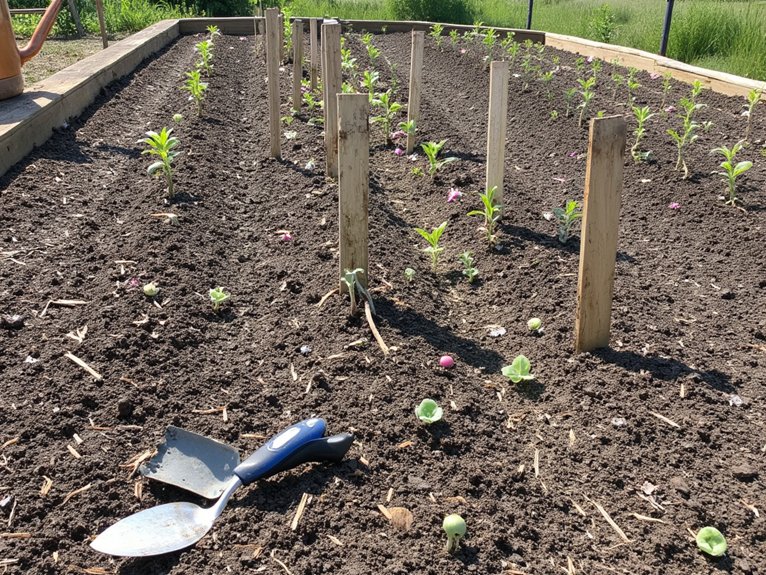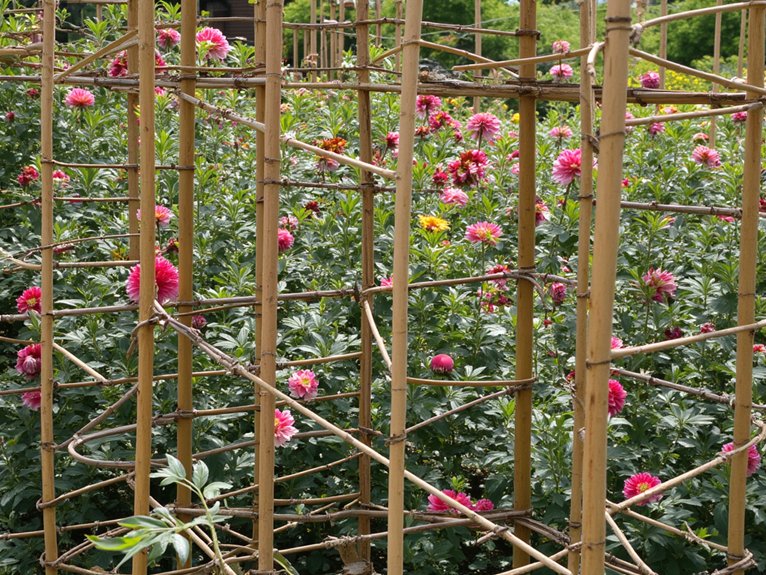Did you know that experienced dahlia growers report up to 40 blooms per plant when using proper techniques? You’ll be amazed at how a few strategic pruning moves and timing tricks can transform your garden into a continuous flower show. “The secret lies in understanding the plant’s growth cycle,” says Master Gardener Sarah Chen. Whether you’re growing dinner-plate varieties or compact pompoms, these proven methods will help you reveal your dahlias’ full blooming potential.
Contents
Setting Your Dahlias Up for Success

Your soil needs to be rich and well-draining with a slightly acidic pH. Mix in organic compost and guarantee proper frost protection by waiting until soil temperatures reach 60°F before planting. Space tubers 1-3 feet apart in holes 6-8 inches deep, with eyes pointing upward.
Essential Soil and Planting Tips
While achieving spectacular dahlia blooms starts with quality tubers, success ultimately depends on proper soil preparation and planting techniques. Your dahlias need rich, well-draining soil with a slightly acidic pH between 6.0-7.0.
Start by incorporating soil amendments like compost and organic matter into your planting bed. Dig holes to the proper planting depth of 6-8 inches, ensuring tubers have room to develop strong root systems. Space them 1-3 feet apart for adequate airflow.
Remember to wait until soil temperatures reach 60°F before planting. Place tubers with the crown facing upward and cover with 2 inches of loose soil.
Supporting Strong Growth Through the Season

Once dahlias begin their seasonal growth, providing consistent support becomes essential for developing strong, healthy plants that produce abundant blooms. You’ll need to stake all but the dwarf dahlia varieties before they reach 12 inches tall.
Drive sturdy stakes 4 inches from each plant, securing stems with soft ties as they grow. Following organic gardening practices, apply a balanced 5-10-10 fertilizer when shoots emerge, then shift to lower nitrogen once buds form. Water deeply at the base, providing 1-2 inches weekly through soaker hoses. Monitor for pests regularly and deadhead spent blooms to encourage continuous flowering.
Mastering the Art of Watering and Feeding
Proper watering and feeding make the critical difference between mediocre dahlia plants and those that produce endless streams of vibrant blooms. You’ll want to maintain consistent watering techniques, providing about 1 inch of water weekly during early growth and increasing to 2 inches when flowering begins.
For fertilization strategies, start with a nitrogen-rich formula (5-10-10) while shoots establish, then switch to a balanced feed once buds form. “The key is delivering water directly to the roots via soaker hoses,” says Master Gardener Alice Chen. “This prevents fungal issues while ensuring deep hydration that supports continuous blooming.”
Expert Techniques for Maximum Blooming

Beyond proper watering and feeding, specific techniques can dramatically boost your dahlia’s blooming potential. “The secret to continuous blooms lies in strategic pruning and pinching during the growing season,” explains veteran dahlia grower Margaret Stevens.
When your dahlias reach 12 inches tall, pinch off the center shoot just above a set of leaves. This encourages multiple bloom varieties to develop. Regular pest management inspections help prevent damage that can reduce flowering. Remove spent blooms every 3-4 days, cutting stems back to the next leaf junction. You’ll notice new buds forming within weeks, extending your blooming season considerably.
Preserving Your Dahlia Garden Year After Year
Creating a lasting dahlia garden requires careful attention to end-of-season tasks and winter storage practices. “The work you put in during fall directly impacts next year’s success,” notes dahlia specialist David Chen.
After the first frost hits, cut stems back to 6 inches and carefully lift tubers from the soil. Clean off excess dirt and inspect for damage. For ideal tuber storage, place them in cardboard boxes with peat moss or sawdust, maintaining temperatures between 35-45°F.
Practice seasonal rotation by moving your dahlia bed to a new location every 2-3 years. This prevents soil-borne diseases and guarantees nutrient-rich growing conditions for future blooms.
